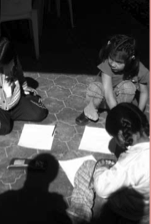Magaly’s Legacy: The San Ramón Network Against Domestic Violence
Building Effective Community Response
On the cool morning of November 25, 2004, Magaly Jara, 34, walked along the dusty lanes of Población La Bandera, a working-class neighborhood in the municipality of San Ramón 20 minutes south of downtown Santiago. After leaving her four children at school, Jara returned home for a moment before joining her parents for breakfast, as planned. Upon entering the house, she came face to face with her former husband, who had jumped the fence and entered the house illegally, despite a court restraining order. During 15 years of marriage, she had endured much abuse and on many occasions since their separation, he had threatened to kill her. Jara screamed, running out of the house, in an attempt to escape, but, in full view of neighbors, the man dragged her back inside. By the time police arrived, he had beaten and finally strangled her to death.
Five blocks away, outside the municipal government offices, the San Ramon Network against Domestic Violence was commemorating the International Day for Elimination of Violence against Women. People had gathered around a stage decorated with profiles of women bearing the message, “Don’t abuse me. Respect me. Don’t beat me.” News of Jara’s murder sent shockwaves and cries of dismay through the crowd.
Four times in the past year, Jara had gone to court seeking protection from the constant threats and violent aggression from her former husband. But the court never transmitted the restraining order to San Ramon police.
The court may have been lax in processing the restraining order because Chilean law at the time considered domestic violence a misdemeanor. In October 2005 the new Intra-Family Violence Law elevated domestic violence to a criminal offense and created Family Courts. However, the vast range of issues assigned to the new court system, a lack of specialized training for judges and a paltry budget have rendered the Family Courts inoperable, with preliminary hearings scheduled an average of seven months after formal complaints are lodged.
Magaly Jara’s death starkly confirmed the results of a 2001 study by EPES (Popular Health Education), a non-governmental organization with 25 years of fostering grassroots participation in health education and in shaping local public health policy. More than 54% of women between 19 and 60 years of age in San Ramón had endured some form of violence—physical, psychological, sexual or economic—from their spouse or male partner (in the Santiago Metropolitan Region the figure is 50%, according to a government report). At the time of the survey, 23 % were experiencing sexual violence. Four out of five of these women were married and were mothers.
The study also revealed a pattern of violence that crosses generations: both victims and aggressors, 62% and 79%, respectively, had been raised in a violent family setting.
For a community the size of San Ramón—100,000 inhabitants in a territory spanning only 12 square miles—such figures are appallingly high.
The prevalence of domestic violence and a lack of services to assist victims spawned the San Ramón Network against Domestic Violence (Red Comunal contra la Violencia Intrafamiliar). Eighteen organizations, including kindergartens, churches, neighborhood clinics, community organizations, a drug prevention program, municipal social services, a child protection service, local police, as well as EPES, came together in a multifaceted effort to break, or at least to mitigate, the cycle of violence locally. Although services exist outside the perimeter of San Ramón, low-income women lack the means to go to another municipality; in addition, the aggressors frequently control a household’s limited resources as well as a woman’s every move.
In 2003, the Canadian Embassy in Chile funded the Network’s first grant proposal, to create the Women’s Assistance Program, along with a Municipal Domestic Violence Referral and Assistance System.
Community awareness and training to respond adequately comprise the Network’s dual focus. Murals, street theater, the distribution of flyers, including the EPES survey results, began to give high visibility to a once-taboo issue in San Ramon. EPES contributed the methodology to train Network entities in domestic violence intervention and gender sensitivity. Teachers, 30 public health employees and all police who receive initial complaints in the local police station have participated in training sessions.
In a modest office she painted herself, psychologist Valeria García, 49, spends her mornings running the Women’s Assistance Program (Programa de Atención a Mujeres), conducting individual and group therapy. So far this year she has provided service to 115 women, ranging in age from 17 to 50 years old. Afternoons, she crosses the hall to the Center for Integral Assistance to Victims of Violence, a Network initiative begun in 2006, to assist women and children; she also talks to men who have committed their first act of violence. García also conducts many San Ramón Network training sessions.
García has participated as community health educator and human rights activist in the La Bandera sector of San Ramón since she was 19, and brings a political perspective to her vocation. “The dictatorship legitimized violence and families reproduced those authoritarian ways. Violence is viewed as a normal way of living and solving problems,” García notes. “The task Network members share is to empower women to understand that no one has the right to treat another person as if you were worthless.”
Network organizations, mainly police and teachers, refer most of the people Garcia assists. The Domestic Violence Referral and Assistance System established a uniform intervention method for women and children victimized by violence. It also set up detailed guidelines for adequate referrals within San Ramón. In the past, victims might be referred to ten different offices, none equipped to do much more than listen. The Referral System assures victims will be attended by the service most appropriate for the characteristics of their case. Moreover, the trust the Network cultivates among its members translates to expedited referrals and professional assistance.
Anabel Del Valle is director of Jardin La Hormiguita kindergarten and also heads a network of 12 public kindergartens attended by 4000 children of San Ramon. La Hormiguita weaves the theme of violence prevention integrally into its curriculum, working with children and their parents or guardians. “We want to engender values such as respect, cooperation, trust, and human rights. The kindergarten teacher is a child’s first contact outside the family circle. A window is open for imbuing that little girl and boy with values that will mature when he or she becomes an adult,” says Del Valle.
Social worker Maria Eugenia Calvin, who represents EPES in the Network, observes, “Little by little, consciousness is building. Today people are daring to speak out. As women begin talking about violence that affects them, they find protection in their community and they begin to change their outlook. Commonly, women blame themselves for the situation they experience. Talking to others, they learn that they are not the cause of what happens to them.”
Magaly Jara, who was unknown to the Network before her murder, has shaped the way people in San Ramón view domestic violence, and galvanized support for the Network. With 25 percent of the population living below the poverty line, domestic violence had never been a high municipal priority. After Jara’s murder, the San Ramón municipal government reaffirmed its commitment to Network programs, and officials participated in the protest rally in front of the house where the young woman died.
“Magaly’s death was a savage blow. But many people who viewed us as madwomen came to understand the legitimacy of our concern only after she was killed,” affirms Calvin. “Magaly represents the failure of a system. And she signals the urgency to continue working together until no one in San Ramón thinks violence is a normal way of life.”
Maxine Lowy, a freelance journalist with a focus on human rights and social issues, worked many years in Hispanic American communities before moving to Chile in 1990. Trained as human rights educator, she is also editor of the Memoria y Justicia website (www.memoriayjusticia.cl).
Related Articles
Salvadoran Youth, Transnationalism’s Other Product
English + Español
A completely distraught junior high school teacher in the Washington DC area approached her assistant principal—a highly-educated white middle-class man—one morning for urgent…
Cuba on the Edge: Short Stories from the Island
If you want to read contemporary Cuban fiction and do not have access to the Spanish original, an increasing number of excellent translations will now allow you to become acquainted with…
Making A Difference: Literacy in Calca
Seated on the floor of their school house twenty attentive first grade eyes watch as Martha turns the pages and asks aloud about the fate of David a friendly llama…





